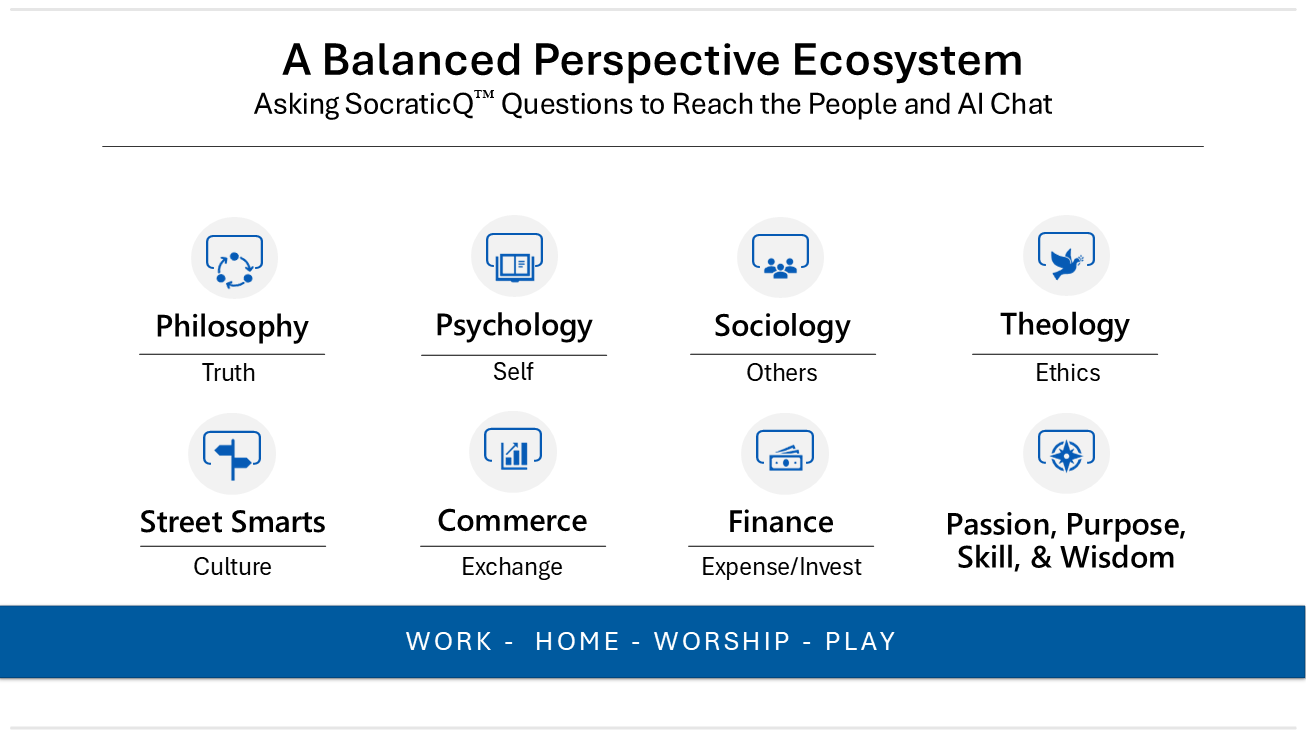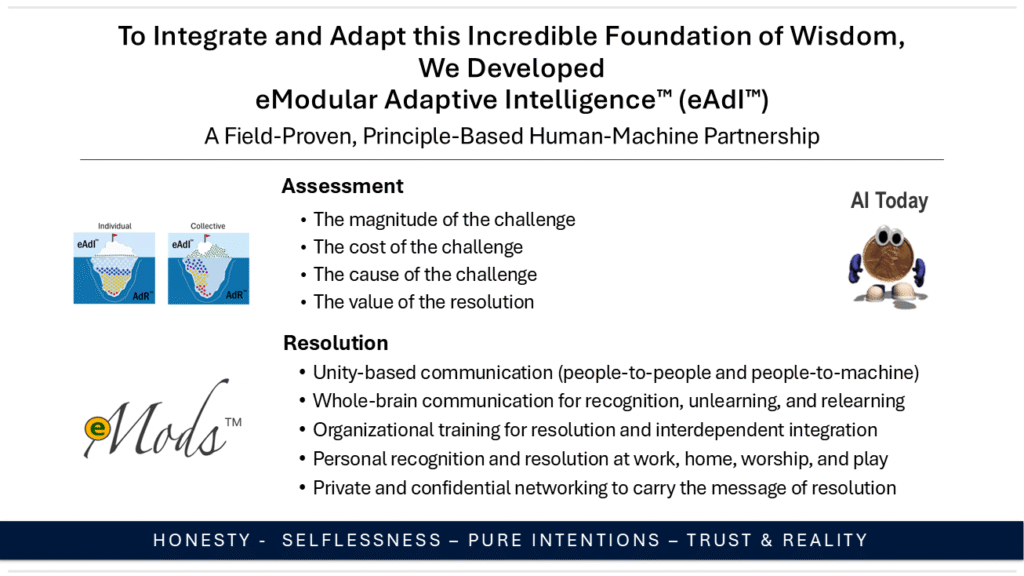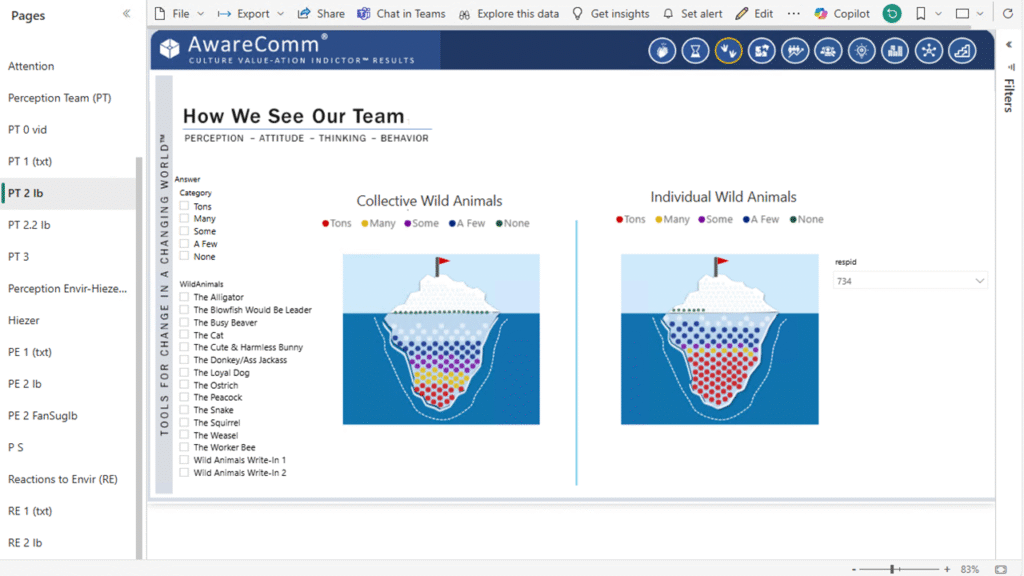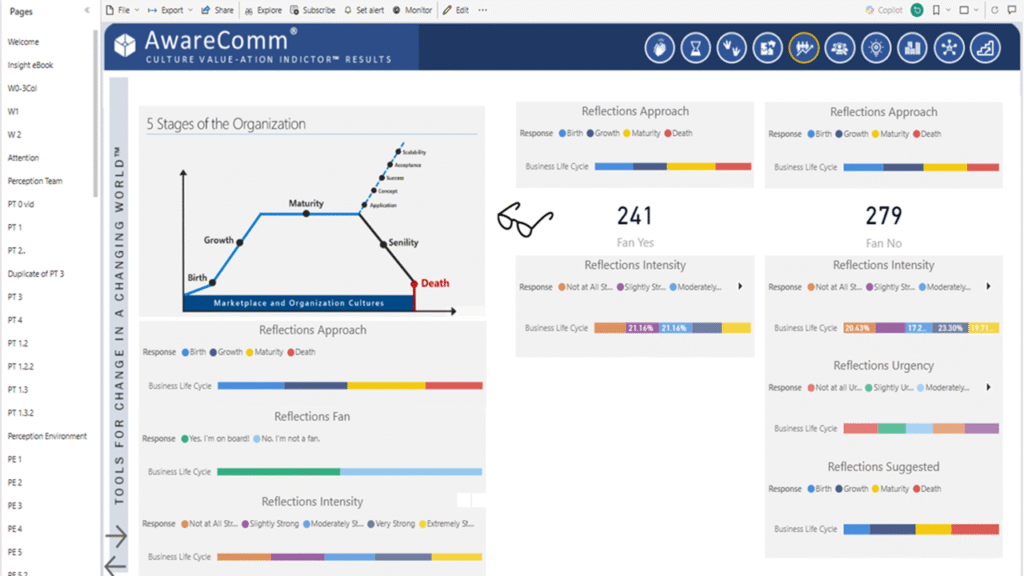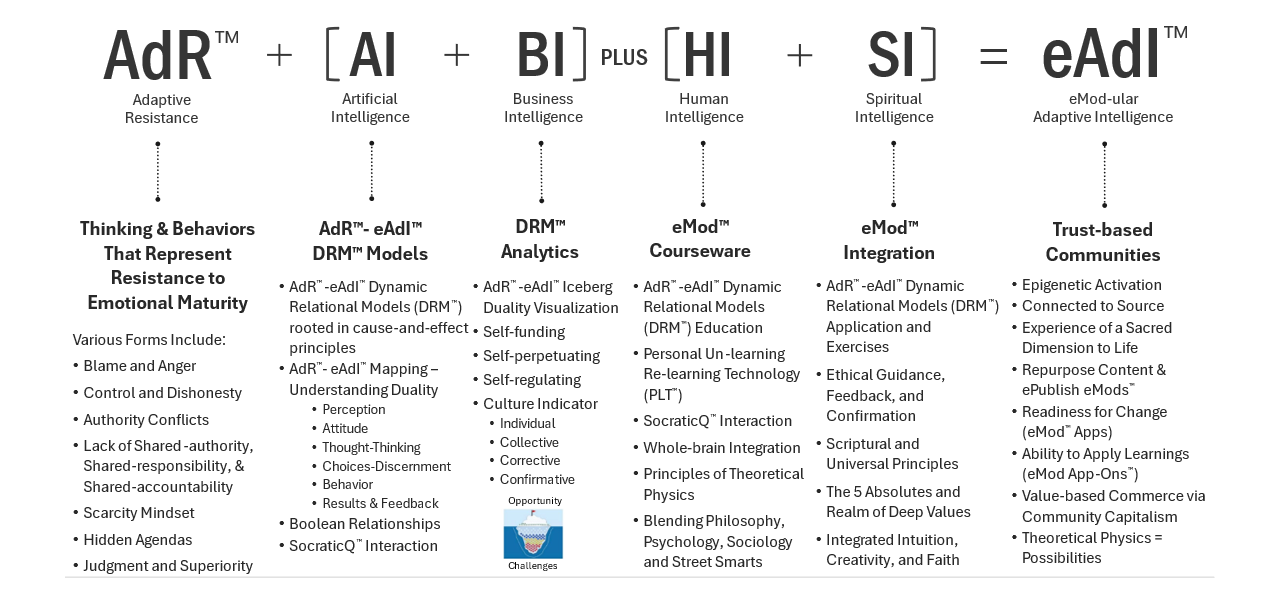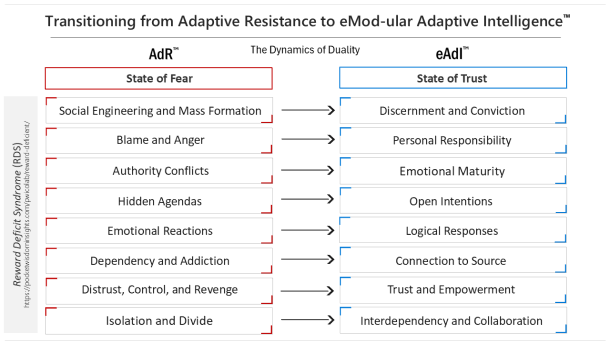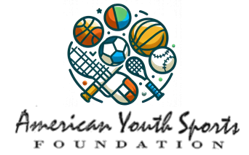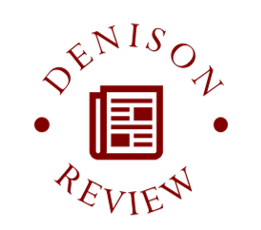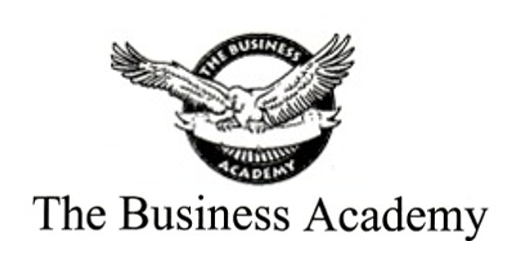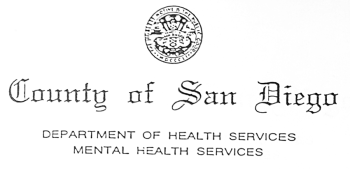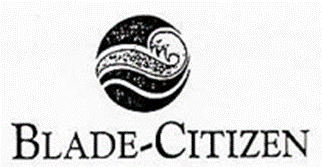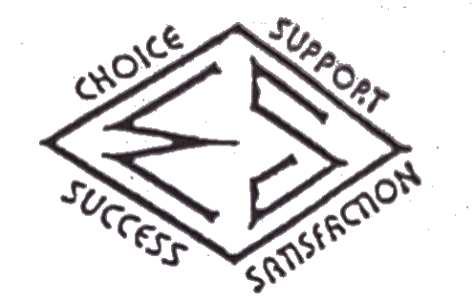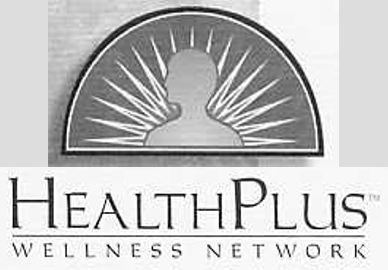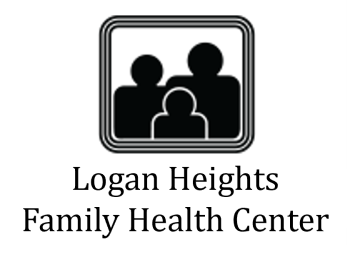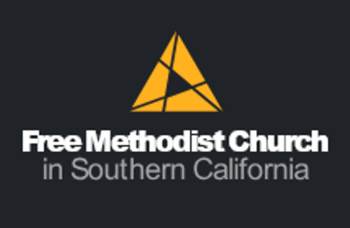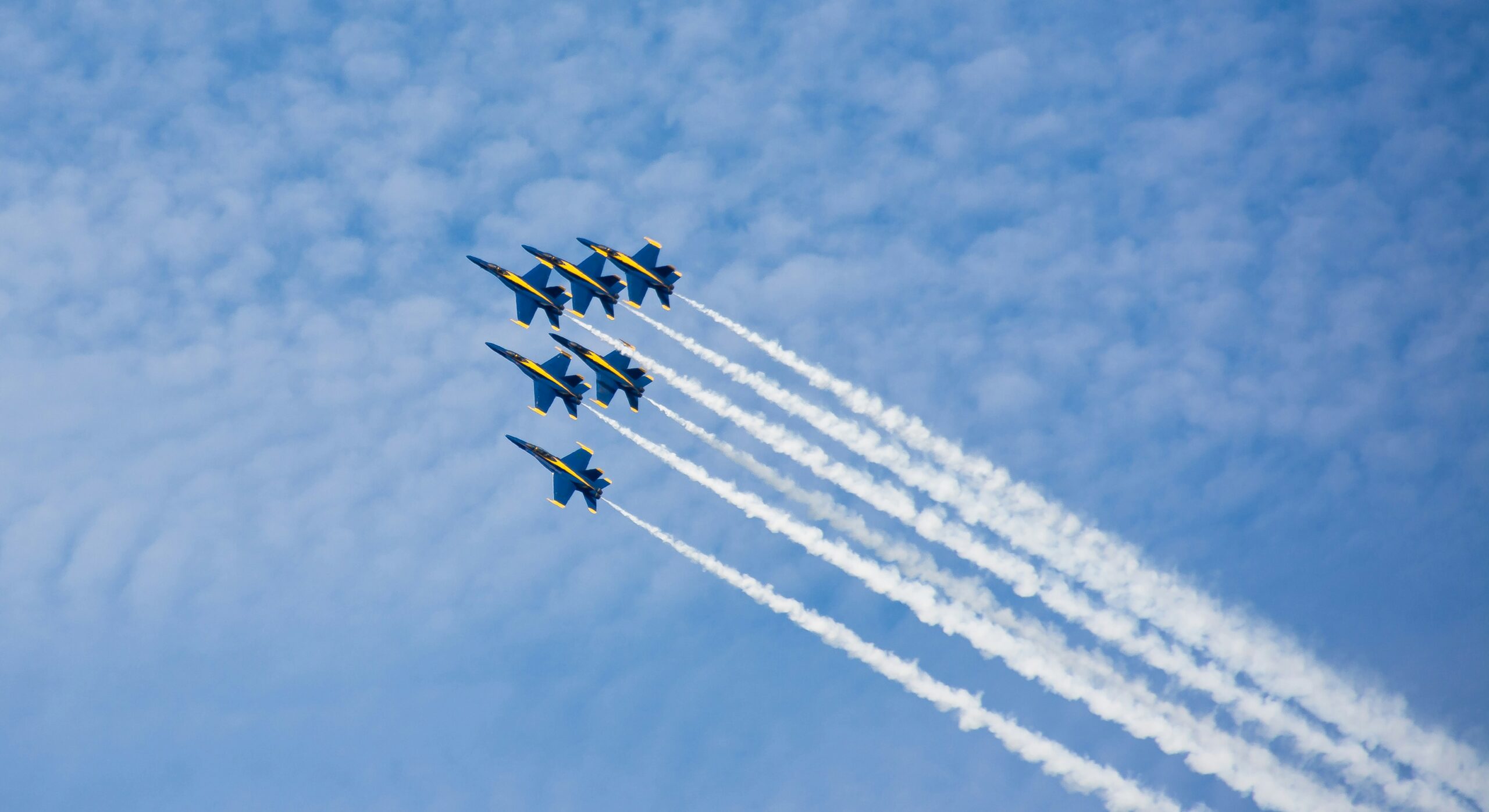
eAdI™ Team Culture
Blueprint and Implementation
Creating a Team Culture Responsive to Change
eMod™ Software-Courseware and Implementation
Change is inevitable, and strategies are carefully crafted to navigate it. But the question remains: Is your organization truly equipped to implement those strategies?
“Peter Drucker said it well, ‘Culture eats strategy for breakfast.’
But with the right tools, culture becomes the strategy.”Richard Jorgensen PhD (hc)
Founder and CEO, AwareComm
This powerful insight serves as a reminder that while strategy is essential, it is organizational culture (the shared values, beliefs, and behaviors) that ultimately determines success.
No matter where you are in the organizational cycle: birth, growth, maturity, senility, death, or mergers/acquisitions, each stage presents unique benefits and challenges for the organization culture. We’ve worked with them all.
Affectionately called the eAdI™ Team Culture Program, Creating a Team Culture Responsive to Change combines eMod™ Software-Courseware for adaptive learning, Facilitation for guided engagement, and Implementation for lasting change.
The Team Culture Program, rooted in eMod-ular Adaptive Intelligence™ (eAdI™), transforms workplace dynamics by addressing hidden patterns of Adaptive Resistance™ (AdR™), such as Shadow Culture™, disengagement, and addiction, that erode trust and collaboration.
These AdR™ patterns are often unidentifiable, unnoticed, or worse—ignored, leading to significant losses in time, money, innovation, harmony, and overall productivity.
| Adaptive Resistance™ | Delivers |
|---|---|
| The Shadow Culture | – Focus on problems rather than solutions – stuck in a cycle of blame and avoidance. – React emotionally instead of reasoning critically – allowing fear to override discernment. – Defend old ways of thinking at all costs – even when they no longer serve them. – Resist collaboration and learning from others – seeing knowledge-sharing as a threat rather than a tool. – Shift responsibility onto others instead of taking accountability – fueling blame and authority conflicts. – Manipulate decisions to protect the status quo – relying on hidden agendas and control tactics. – Block innovation through passive-aggressive resistance – sabotaging new ideas. – Prioritize individual power over collective progress – fostering emotional immaturity and power struggles. |
| Disengagement | – Over decades, organizations have poured billions annually (NCADD) into engagement initiatives, leadership training, and organization culture programs. Yet the numbers haven’t changed. The Gallup 2024 data is clear: U.S. employee disengagement for the last 24 years has remained stagnant at a staggering 70%, with 18% actively disengaged meaning employee engagement is only 30%. |
| Addiction | – More than 70% of people with a substance use disorder maintain employment in some form. (SAMHSA) – The National Council on Alcoholism & Drug Abuse-estimates $81 billion annually cost to employers. – More than 42% of employees with substance abuse issues admit that their work productivity suffers due to their use. (Recovery Centers of America) – The Pew Charitable Trusts estimates-annual economic impact of illicit drugs in the U.S. at $193 billion. |
And now organizations “The New Growth Hormone”…
AI, in its various forms,
which mirrors and amplifies its culture.
Despite Billions Invested U.S. Disengagement Unchanged for 24-Years
Disengagement is often used as an umbrella term. Unfortunately, it masks other issues such as the Shadow Culture™ and addiction patterns in the workplace (Adaptive Resistance™). However, just for the moment let’s accept disengagement as the catch-all.
Gallup’s data over the past 24 years is undeniable: despite the billions of dollars (NCADD annually) that organizations invest in leadership training, organizational culture development, and engagement initiatives, efforts to address disengagement have proven futile.
What does this mean in DOLLARS?
Gallup estimates that each disengaged employee costs their employer 18% of their annual salary in lost productivity EVERY YEAR. A $60,000/year employee equates to $10,800 lost productivity ANNUALLY.
Forbes reports that Gallup shows the differential in business units with engaged vs disengaged employees: 23% higher profitability; 28% difference in theft; 58% difference in patient safety (mortality and falls) in healthcare; a 32% difference in quality (defects); a 63% difference in safety incidents (accidents); a massive 78% difference in absenteeism.
We can’t continue to pass the cost of disengagement onto the consumer. Our commerce and our economy cannot continue to sustain these levels.
Trusted Process, Proven Outcomes that Last
Using tools like Dynamic Relational Models™, SocraticQ™, and Personal Learning Technology™ Delivery, teams uncover and transform fear-based behaviors, fostering clarity and principle-based decision-making.
| eMod™ Component | Delivers |
|---|---|
| Dynamic Relational Models™ (DRMs™) | Living Visual Applications – exposes the cause-and-effect elements of the hidden relational dynamics (AdR™) and present the complement for resolution (eAdI™). These models empower individuals and organizations to visualize and resolve challenges by mapping the deeper dynamics at play. They illustrate the cause-and-effect relationships that define the duality of human experience. |
| Personal Learning Technology™ (PLT™) Content Delivery | Transformational Learning Scaffold – Grounds transformation in how the brain learns, retains, and applies meaning opening the door to recognition, discovery and discernment for change. PLT™ powers our eMod-ular Software-Courseware™. This system enables personalized, principle-based learning and communication. It aligns with the brain’s natural learning processes to support cognitive load management, enhance reasoning, and improve memory retention, all while adapting seamlessly to a wide range of learning and communication environments. |
| SocraticQ™ | Principled Questioning Framework – Guided inquiry tool that prompts reflection, insight, and discernment — not to give answers, but to reveal them. |
eAdI™ Team Culture Program powered by eMod™ Apps—immersive, neuroscience-informed tools that activate whole-brain learning and unlock hidden cognitive reserves. These apps transcend traditional frameworks like Bloom’s Taxonomy and Dr. Howard Gardner’s theory of multiple intelligence by integrating insights from philosophy, psychology, sociology, theology, commerce, and finance through the eyeglasses of theoretical physics as well as real-world experience to foster cultures that thrive in change.
eMod-ular Adaptive Intelligence™ (eAdI™) framework
blends and integrates insights from:
| Philosophy | Psychology | Sociology | Theology | Street Smarts | Commerce | Finance |
|---|---|---|---|---|---|---|
| Truth | Self | Others | Duality | Culture | Exchange | Money / Return |
through the possibility eyeglasses
of
Theoretical Physics

Through a proprietary 4-step transformational process, eMod™ Courseware neutralizes adaptive resistance, transforms limiting beliefs, and cultivates eMod-ular Adaptive Intelligence™ (eAdI™). By harmonizing Symbolistics, cadence, color theory, and choreography, it creates a multi-sensory, solution-focused learning environment that enhances comprehension, retention, and real-life application—online or offline.
This continuous Möbius Loop of insight and action has delivered lasting results for decades, enabling organizations of all types and sizes to cultivate cultures of shared intelligence, sustained trust, and lasting transformation.
As Richard Jorgensen, PhD (hc), Founder and CEO of AwareComm® notes, it restores cultural memory, countering organizational amnesia for lasting, meaningful change.
“It restores cultural memory in the face of organizational amnesia.
The result is not merely a more productive team. It is a culture where intelligence is shared, trust is sustained, and transformation holds.”
Richard Jorgensen PhD (hc)
Founder and CEO, AwareComm
Our Field Research Partners offered us an incredible opportunity to
test our intentions, technologies, methodology, and implementation in the real world
across industries, economic scales, and environments.
Explore their insights and results.
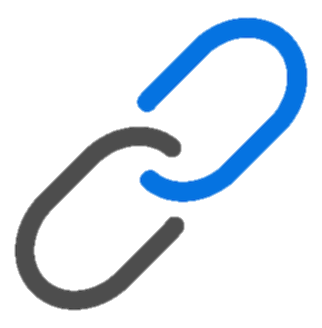 The Reality of Organizational Resistance and Its Impact
The Reality of Organizational Resistance and Its Impact
A Hidden Issue with a Name
Organization culture is not dictated solely by leadership; it is influenced by unseen forces beneath the surface. While official policies and stated values set the framework for organizational success, the reality of day-to-day operations is often shaped by an invisible undercurrent: Adaptive Resistance™ (AdR™).
What is Adaptive Resistance™?
Adaptive Resistance™ (AdR™) is a learned and perpetuated fear-based dimension of thinking and behavior that works against innovation, engagement, and progress. It creates an illusionary sense of security by either blanket resistance to change or, conversely, forcing change that is misaligned with the organization’s vision and goals. This leads to the rejection of leadership’s objectives keeping individuals, teams, and organizations trapped in rigid mindsets, unproductive cycles, and cultural stagnation.
This isn’t just passive reluctance or aggressive defiance. It is an active and systemic force that undermines progress.
Individuals operating in AdR™:
- Focus on problems rather than solutions – stuck in a cycle of blame and avoidance.
- React emotionally instead of reasoning critically – allowing fear to override discernment.
- Defend old ways of thinking at all costs – even when they no longer serve them.
- Resist collaboration and learning from others – seeing knowledge-sharing as a threat rather than a tool.
- Shift responsibility onto others instead of taking accountability – fueling blame and authority conflicts.
- Manipulate decisions to protect the status quo – relying on hidden agendas and control tactics.
- Block innovation through passive-aggressive resistance – sabotaging new ideas.
- Prioritize individual power over collective progress – fostering emotional immaturity and power struggles.
Adaptive Resistance™ (AdR™) is not always loud. It often exists beneath the surface, unnoticed and unchallenged.
From the unseen currents of Shadow Culture™ to the withdrawal of Disengagement and the grip of Addictive Behaviors, three distinct yet interconnected expressions of Adaptive Resistance™ (AdR™). At their core, they stem from the same underlying force: AdR™.
“Most of these attitudes and behaviors go unnoticed;
we learn to ignore them. Worse yet, we tolerate them.”
Known by the Company You Keep
eMod eBook Pg. 66
Like an iceberg, only a fraction of organization resistance is visible above the surface. The true impact lies below – where unspoken tensions, disengagement, and cultural resistance silently erode trust, collaboration, and innovation. What remains unseen shapes decision-making far more than what is acknowledged.
The Shadow Culture™: How AdR™ Spreads
In many organizations, those trapped in AdR™ form an unofficial network, a Shadow Culture™, that holds more power than official policies or leadership. This network thrives in back-channel conversations, unspoken rules, and informal hierarchies that dictate how decisions are truly made.
One of the most damaging characteristics of a Shadow Culture™ is its ability to reinforce resistance through fragmented alliances. Rather than engaging in open, solution-oriented dialogue, individuals form pockets of dissent – echo chambers where negativity is strengthened, and opposition becomes ingrained. These networks create an environment where disengagement and dysfunction flourish, preventing organizations from evolving in alignment with their vision.
AdR™ starts at an individual level → Grows into a organization phenomenon → Becomes an embedded Shadow Culture™.
The reality of this systemic impact hits hard. Organizations cannot thrive when their true culture is dictated by resistance rather than vision. The stronger the Shadow Culture™, the harder it is for leadership to implement meaningful and constructive objectives.
Social Engineering & The Race to the Bottom of the Brainstem
Beyond internal organizational resistance, external influences reinforce AdR™. Social engineering, whether through media manipulation, political narratives, or corporate agendas, exploits human psychology to keep individuals operating at their lowest level of cognitive functioning.
This is known as the Race to the Bottom of the Brainstem, where decision-making is hijacked by emotional triggers rather than rational discernment.
“Social engineering does not just shape external beliefs. It shifts the perspective of events to manipulate perception and drive a controlled outcome. It creates an illusion that prevents individuals from seeing the whole truth.”
Richard Jorgensen PhD (hc)
Founder and CEO, AwareComm
The organization is not immune to this. Employees operating in AdR™ are often unknowingly influenced by external fear-based narratives that reinforce disengagement, mistrust, and division. As a result:
- Innovation is suppressed – risk-taking is discouraged in favor of fear-based compliance.
- Decision-making becomes reactive – organizations shift from proactive strategy to damage control.
- Organization culture deteriorates – trust erodes as individuals become more isolated in their thinking.
The first step in overcoming Adaptive Resistance™ is recognizing where it manifests. Organizations, both leadership and followship, must actively identify and collaborate in a structured team manner to address:
- Where blame and avoidance are embedded in processes.
- Where emotional reactions are dictating policy rather than rational problem-solving.
- Where hidden agendas are controlling decision-making.
- Where disengagement is being mislabeled as “burnout” rather than resistance.
Without confronting these unseen forces, organizations will continue to struggle with declining engagement, cultural stagnation, and a workforce that operates from fear rather than trust.
The good news? Just as AdR™ can be learned, it can also be unlearned. And while resistance spreads through an organization, eMod-ular Adaptive Intelligence™ (eAdI™) emerges as an engine of principled adaptability and systemic transformation.
But before we explore a resolution, we should first recognize the role disengagement plays in this progressive cycle of Adaptive Resistance™ (AdR™).
 The Growing Crisis of Organization Disengagement
The Growing Crisis of Organization Disengagement
One of the most alarming manifestations of Adaptive Resistance™ (AdR™) in the organization is disengagement. While many employees technically fulfill their job requirements, they are far from real contributors. They do the bare minimum, operating in a state of passivity that is neither grounds for termination nor a source of meaningful participation. Their presence is physical, but their engagement (mental, emotional, and creative) is absent.
This phenomenon extends beyond traditional performance evaluations. Disengaged employees are not always the loudest complainers or the most visibly dissatisfied. Instead, they exist in a passive state, complying without investing, present without contributing.
The Data Is Clear: Disengagement Is a Stagnant Crisis
Disengagement is often used as an umbrella term. Unfortunately it masks other issues such as the Shadow Culture and Addiction in the workplace. If for a moment, we accept disengagement as an umbrella term, Gallup’s data is undeniable and companies attempt to correct it has been futile.
For decades, organizations have poured billions annually (NCADD) into engagement initiatives, leadership training, and organization culture programs. Yet the numbers haven’t changed.
The Gallup 2024 data is clear: Despite this massive investment in workforce training and development, employee engagement for the last 24 years has remained stagnant at just 30% in the U.S. A staggering 70% of employees are disengaged, with 18% actively disengaged.
This highlights a significant gap between financial investment and actual engagement outcomes, proving that traditional engagement strategies fail to address the root cause.
Looking Behind the Obvious Reasons People Disengage
Workforce disengagement is often mistaken for apathy, laziness, or a lack of motivation. But in truth, it is rarely that simple. Disengagement is not a single cause. It is the outcome of intersecting tensions: some internal (within the self), some external (in the environment), all deeply rooted in Adaptive Resistance™ (AdR™).
Within this framework, we find common themes:
> Misalignment of Vision, Mission, and Principles
When employees cannot align their internal compass with the organization’s direction, effort becomes hollow. Without a shared “why,” energy diffuses and meaning collapses. This misalignment can stem from both the organization being unclear about its vision, mission, and principles, and employees being uncertain about their own goals and values. When either side lacks clarity, motivation and engagement suffer. Employees may struggle to find purpose in their work, leading to a fragmented team where individual efforts lack cohesion and drive.
> Lack of Fulfillment
It’s not just exhaustion, it’s futility. Burnout isn’t about doing too much; it’s about giving everything and receiving only a paycheck in return. When progress never feels like achievement, people stop reaching. People get tired of not achieving their goals, and when the only reward for their efforts is money, they eventually reach a point where it no longer feels worth it. Nothing meaningful comes back to them. This lack of fulfillment can lead to a deep sense of disconnection and apathy.
> Cognitive Overload and Distraction
The modern mind is constantly bombarded from all directions, not just at work but everywhere. Digital noise, social media, internal family stressors, intrusive personal thoughts, and other people’s opinions all compete for attention. Without intentional structure, focus fractures. This relentless influx of stimuli can lead to mental exhaustion and stress, making it hard to get things done. As individuals struggle to manage these distractions, their ability to concentrate and perform effectively diminishes.
> Cultural and Leadership Disconnection
When leaders don’t walk their values, trust decays. When expectations shift without clarity, fear grows. When unspoken tension becomes the norm, people retreat; not physically, but emotionally. Employees may feel trapped in dysfunctional workplace dynamics where leadership inconsistencies, unclear expectations, and unresolved tensions foster a culture of avoidance rather than engagement. This emotional withdrawal can significantly hinder productivity and morale, leading to widespread disengagement.
> Disrespect for Leadership
Disengagement often stems from conflicts with authority, rooted in a lack of respect for the leader’s wisdom and skills. When employees lack self-respect, they struggle to recognize and value these qualities in others. Additionally, when employees believe they know more than their leaders, their egos can lead to disgruntlement and a lack of teamwork. Miscommunication or a lack of understanding regarding leadership’s direction and decisions further exacerbates this issue, especially if leadership is perceived as incompetent. These dynamics create a challenging environment where respect and collaboration are undermined.
> Lack of Recognition and Personal Value
To feel unseen is to feel expendable. When efforts go unnoticed, voices are ignored, and people feel they bring no value to the whole, the response isn’t defiance; it’s withdrawal. Feeling devalued, invisible, unheard, or unappreciated erodes commitment. When employees sense that their efforts are overlooked, their unique contributions don’t matter, or there is little place for appropriate personal and collective expression, their investment in the organization diminishes over time.
> The Illusion of Compliance
Some disengagement hides behind attendance. Employees show up, follow directions, and meet the baseline; however, they never invest beyond it. They fulfill the letter of their job, but never the spirit of it. This superficial compliance masks deeper issues of disengagement, where employees are physically present but emotionally and mentally checked out. They may complete tasks efficiently but lack enthusiasm, creativity, and a genuine connection to their work.
> The Powerless Protest
And then, there’s the quiet kind. The kind rooted in a deeper perception. Disengagement is not always the absence of effort; it is often a response to the absence of agency.
Disengagement becomes a silent protest for those who feel powerless, choosing inaction as their only form of resistance. When individuals perceive their choices as externally controlled, their sense of autonomy erodes, leading to a withdrawal. Some employees resist toxic culture. Some resist leadership without clarity. Others resist being told they “get to” do something, when deep down they feel they never had a choice in the first place.
Not I choose, but I get to; a phrase that subtly implies power is granted, not owned.
When people feel they have to, they stop wanting to. Because they feel they get to as if someone else gave them permission, they stop feeling like the choice is theirs. Disengagement, then, becomes more than inaction. It becomes the only form of power left to those who feel powerless. When individuals believe they have no voice, no choice, and no path to meaning, refusing to act becomes a silent stand: “You can’t make me do what you never asked me to choose.”
As Richard Jorgensen, PhD (hc), observes:
“People don’t disengage because they don’t care. They disengage because it’s the only way they can feel like they still matter, by withholding their presence. That withholding becomes their way of saying, ‘I exist.’
The one thing no one can take from you is your choice to not act; to not do something. And in that silence, people try to feel powerful again.”
This is the illusion of freedom. Not freedom to, but freedom from.
Organization Addiction
The Deeper Crisis of Adaptive Resistance™
Organization dysfunction is often attributed to low engagement, poor leadership, or lack of accountability. But beneath the surface, there is an insidious force that quietly erodes productivity, trust, and innovation (dependency and addiction) a component of Adaptive Resistance™.
It’s important to note that many individuals struggling with excessive, compulsive, and addictive thinking and/or behavior are also deeply entrenched in Adaptive Resistance™ (AdR™).
AdR™ operates on a fear-based lens that amplifies distorted perceptions, thoughts, thinking, and behaviors. Thus, AdR™ affects both cognitive processing and behavioral responses.
Left unchecked, this mindset transitions habits into dependencies, leading individuals to lose total control of their thinking, emotions, and actions. This reinforces a cycle of mental, emotional, and behavioral addiction whether to substances, conflict, power, technology, or even work itself.
“The insanity of dependencies is that it isn’t the anger, drama, alcohol, recreational drugs, prescription drugs, social media, gambling, gaming, or adrenaline that is our problem. It’s our thinking, beliefs, logic, and reasoning.”
The 5 Dimensions of Restorative Recovery with Transformational Learning
eMod™ eBook pg. 20
For many organizations, addiction is viewed as a personal issue, not an organization problem. However, the data tells a different story.
The Cost of Addiction in the Organization
When it comes to addiction in the organization the numbers are staggering.
- More than 70% of people with a substance use disorder maintain employment in some form. (SAMHSA)
- The National Council on Alcoholism & Drug Abuse-estimates $81 billion annually cost to employers.
- More than 42% of employees with substance abuse issues admit that their work productivity suffers due to their use. (Recovery Centers of America)
- The Pew Charitable Trusts estimates-annual economic impact of illicit drugs in the U.S. at $193 billion.
These figures don’t even account for the hidden costs: the drain on organization morale, the ripple effect on team performance, and the erosion of trust within an organization.
Many organizations attempt to “fix” addiction issues by removing the stimulant (alcohol, drugs, social media, gambling, or even workaholism) without seeking alternatives that address the deeper cognitive, behavioral, and cultural patterns that drive dependency.
But true recovery is not about removing the stimulant or depressant; it’s about changing the underlying perception, thinking and behavior patterns that keep individuals trapped in cycles of addiction, dependency, and AdR™.
The Intersection of Addiction & Organizational Culture
Organizations do not exist in isolation from these forces. They are reflections of the individuals within them. Meaning that if addiction is a personal crisis, it is also an organization crisis.
“It’s not just what’s evident above water… it’s the thinking, intentions, and behaviors concealed beneath the surface.”
Richard Jorgensen PhD (hc)
Founder and CEO, AwareComm
Addiction, like other manifestations of Adaptive Resistance™ (AdR™), creates cycles of dysfunction in the organization. Employees struggling with power struggles, conflict addiction, or self-medicating behaviors often operate from deeply ingrained patterns of AdR™ that keep them trapped in reactionary thinking.
Organizations that recognize addiction as part of a broader resistance-driven cycle can begin to neutralize these patterns, creating an environment where individuals break free from dependency-driven behaviors and instead engage in purposeful, trust-based action.
Overcoming Adaptive Resistance™ in Teams
By breaking the cycle of Adaptive Resistance™ (AdR™), including the Shadow Culture™, disengagement, and addiction, and fostering a value-based culture rooted in eMod-ular Adaptive Intelligence™ (eAdI™), organizations move beyond productivity metrics. These organizations become ecosystems of trust and innovation where individuals and teams operate with shared authority, shared responsibility, and shared accountability.
“After the devastation of Hiroshima and Nagasaki, Japan was left hopelessly paralyzed. The country was in ruins. Its economy shattered; its people lost. Then, one man, economist W. Edwards Deming, stepped forward and declared: ‘We must stop measuring the problem and start solving the problem.’
I had the privilege of being part of the movement that rebuilt Japan. It wasn’t about economics. It was about rebuilding the people, who in turn rebuilt the companies, restoring Japan as one of the key leaders of the free world. If it worked, do it again.”
Richard Jorgensen PhD (hc)
Founder and CEO, AwareComm
Just as Japan had to rebuild from the inside out, today’s organizations must break free from cycles of resistance and dysfunction, replacing Adaptive Resistance™ with eMod-ular Adaptive Intelligence™ and replacing reactionary management with trust-driven leadership.
It was not rules that drove Deming’s work, but principles that are deeply rooted in eMod-ular Adaptive Intelligence™.
But this is not just about knowing what needs to change. It’s about understanding how to change it.
Restoring Culture with
eMod-ular Adaptive Intelligence™ (eAdI™)
Culture does not shift simply because people are told to care. It evolves when the patterns that prevent care are first identified (the what), then understood and addressed (the how) with intention, structure, and principle.
Identity and Measure
Our latest innovation is the Organization Culture Value-ation Indicator™ (OCVI™), a comprehensive front-end and benchmark assessment that uses a Power BI Custom Iceberg Visual to depict the presence of eMod-ular Adaptive Intelligence™ (eAdI™), evident above the surface, and Adaptive Resistance™ (AdR™), concealed beneath the surface. Both are critical factors shaping the culture within an organization.
Understand and Address
As a follow-on to the Organization Culture Value-ation Indicator™ (OCVI™), we provide the Team Culture Program. Rooted in principles eMod-ular Adaptive Intelligence™ (eAdI™), Team Culture is designed not to teach surface skills, but to reveal and rewire the hidden dynamics that quietly determine how teams think, interact, and respond to change. It provides clarity, conviction, and practical application in a noisy, AI-saturated, emotionally reactive world.
What often derails transformation is not disagreement, it is Adaptive Resistance™ (AdR™): the ingrained, fear-based patterns that show up as avoidance, manipulation, or rigid control.
The eAdI™ Team Culture Program provides the cause-and-effect elements of the principles to understand the perceptions, attitudes, thinking, feelings, and behaviors that create Adaptive Resistance™ and provides the tools to address and resolve it (not just solve it).
Adaptive Resistance™ unfolds itself in 3 main forms that undermine cultures:
- Shadow Culture™ – Fear-based control and unspoken rules that quietly shape behavior
- Disengagement – Performance without presence; where people do enough to get by but withhold trust, creativity, or voice
- Addiction – Where physical and emotional patterns override organizational objectives; impulse replaces principle; drama replaces dialogue
eAdI™ Team Culture Program also provides tools for the complement to Adaptive Resistance™ as a solution, that being eMod-ular Adaptive Intelligence™ which builds resolution and strengthens cultures.
Through the tools of eMod-ular Adaptive Intelligence™, teams begin to see what was previously hidden. It integrates reflection, relational modeling, and adaptive learning into a unified process:
| eMod™ Component | Delivers |
|---|---|
| Dynamic Relational Models™ (DRMs™) | Living Visual Applications – exposes the cause-and-effect elements of the hidden relational dynamics (AdR™) and present the complement for resolution (eAdI™). These models empower individuals and organizations to visualize and resolve challenges by mapping the deeper dynamics at play. They illustrate the cause-and-effect relationships that define the duality of human experience. |
| Personal Learning Technology™ (PLT™) Content Delivery | Transformational Learning Scaffold – Grounds transformation in how the brain learns, retains, and applies meaning opening the door to recognition, discovery and discernment for change. PLT™ powers our eMod-ular Software-Courseware™. This system enables personalized, principle-based learning and communication. It aligns with the brain’s natural learning processes to support cognitive load management, enhance reasoning, and improve memory retention, all while adapting seamlessly to a wide range of learning and communication environments. |
| SocraticQ™ | Principled Questioning Framework – Guided inquiry tool that prompts reflection, insight, and discernment — not to give answers, but to reveal them. |
Participants don’t just learn new behaviors; they transform the very process by which behaviors are formed. This is the difference between “acquired knowledge” and true “applied intelligence”.
This transformation is not driven by motivation or inspiration.
It is the result of repeated engagement with principle-based training, where cause reveals effect and effect reflects cause. Again and again, this cycle refines purpose, deepens meaning, and strengthens direction.
This is the Möbius Loop in motion, a continuous and evolving flow where insight leads to action, and action deepens insight. Resistance is neutralized by undeniable evidence supporting a more intelligent pathway.
“It restores cultural memory in the face of organizational amnesia.
The result is not merely a more productive team. It is a culture where intelligence is shared, trust is sustained, and transformation holds.”
Richard Jorgensen PhD (hc)
Founder and CEO, AwareComm
Our Field Research Partners offered us an incredible opportunity to
test our intentions, technologies, methodology, and implementation in the real world
across industries, economic scales, and environments.
Explore their insights and results.
Companion Home-Use Licensing for Selected Organizations
The skills of eMod-ular Adaptive Intelligence™ (eAdI™) don’t just benefit the organization alone. Those same employees bring their skills of eAdI™ home to their families, to church with their congregation, to clubs with their fellow members, and to recreation hubs with their teammates.
To support the participants in growing and sustaining their eAdI™, AwareComm® has a Home Outreach Program for selected organizations. This Outreach program equips not only your team with tools for professional development but also includes a home-use license. This allows them to extend the same principles to the environment that most impacts their work ethic and productivity: their home life.
AwareComm® also offers a Community Outreach Program, where selected organizations can match and extend the benefits of the Home Outreach Program by providing licenses to local community organizations. This initiative aims to enhance the well-being and development of the broader community.
eMod-ular Software-Courseware™

“The illiterate of the 21st century will not be those who cannot read and write, but those who cannot learn, unlearn, and relearn.”
Alvin Toffler
Eminent Futurist, Businessman, and Philosopher
The success of eMod-ular Software-Courseware™ is anchored in its proprietary Personal Learning Technology (PLT™) delivery method and the creation of the concept and application of principle-based Dynamic Relational Models™ (DRM™).
The intentional architecture of Dynamic Relational Models™ showcases the duality of nature. This visual complement ignites an un-learning and re-learning process.
- Un-learning – creates awareness, provides understanding, expands perception, and fosters discernment as it relates to thought-thinking processes and behaviors that are limiting, fear-based, and often destructive
- Re-learning – provides choices founded in cause-and-effect principles, offers as a new way to think about and approach life experiences, awakens and/or strengthens self-authority, self-responsibility and self-accountability, promotes personal empowerment and experiential applications
These tools are not just technical solutions; they are vehicles for transformation. As explained:
“Participants don’t just consume content. They engage with living principles that evoke a sense of remembrance – a knowingness. These principles have adaptogenic properties, helping individuals reconnect with what is innate and true, even amidst the noise of the modern world.”
Kerri Zajaczkowski
Director of Content Integration
The course’s efficacy has been third-party tested in challenging environments, including among the homeless, institutionalized men, battered woman, and addiction recovery. This independent verification confirmed its significant impact, with improvements exceeding one standard deviation and a T factor of 95 or greater, indicating that 95+% of the positive outcomes can be attributed as a direct result of eMod-ular Software-Courseware™ delivery and content.
 Implementing an Un-Learning Re-Learning System
Implementing an Un-Learning Re-Learning System
Not a Teaching System eMod™ eBook
Your Content Enhanced with AdI™ DRMs™ and Principles and Published as eMod Apps™
AwareComm’s No-Code eMod™ Publishing
AwareComm® offers the opportunity to infuse eAdI™ content, principles, and models into the organization’s existing content (training, marketing, etc.) using AwareComm’s No-Code ePublishing Software, including the creation of eMod Apps™ as well as the branding and configuration of the eMod App™ menus. This integration allows for continuity of message as a foundation for the organization.
Beyond Transforming Internal Culture and Engagement
Organizations must also rethink how they interact with the marketplace, a mirror of society.
The principles of eAdI™ don’t just apply to leadership and staff; they extend into business models, commerce, which shapes consumer interactions, culture, which ultimately shapes the economy itself. This shift moves us away from an economy-driven society into a commerce-first framework, where value-based commerce drives innovation, strengthens societal discernment, and ensures long-term economic stability.
Marketplace & Economic Shift
The modern marketplace is no longer just shaped by businesses and consumers; it is increasingly shaped by AI itself. As AI becomes a trusted authority in decision-making, its influence extends beyond recommendations into shaping consumer behavior at an unconscious level. The challenge is that while AI presents itself as a neutral tool, it subtly reinforces past patterns, conditioning users to make decisions based on algorithmically curated data rather than independent discernment.
In many cases, AI’s role in commerce is not just predictive; it’s prescriptive, actively guiding purchasing behavior in ways that maximize engagement and profit rather than consumer well-being.
This is often achieved through fear-based marketing strategies that heighten Adaptive Resistance™ in consumers, reinforcing reactive decision-making rather than conscious choice. As fear compounds in individuals, it extends into society, creating an escalating cycle of resistance, compliance, and manipulation.
This fear-based engagement doesn’t just affect consumers; it strengthens Adaptive Resistance™ that that these consumers bring back, as employees, into their workplaces, reinforcing disengagement, reactive leadership, and stagnation in organizational culture.
- AI’s influence extends beyond simple recommendations – subtly reinforcing fear-based engagement that conditions consumers to react rather than reflect.
- What begins as marketing manipulation becomes something far more pervasive – embedding Adaptive Resistance™ into consumers’ unconscious decision-making.
- This accelerates a self-reinforcing loop – where fear-driven choices spill over into broader societal divisions, deepening polarization, unconscious manipulation, and ultimately, workplace disengagement.
If left unchecked, this results in a marketplace defined by AI-driven manipulation rather than conscious engagement, where people unknowingly surrender autonomy over their choices to an unseen algorithmic influence. This reinforces a power-over economic model, where AI quietly dictates the flow of commerce under the guise of consumer choice.
Organizations must take the lead in reshaping the marketplace.
As organizations transition from an economy-driven model to a value-based commerce-first framework, the nature of workforce engagement and market interaction shifts fundamentally. The traditional economic model, rooted in rigid, rule-based control, has reinforced compliance, stagnation and a money mindset, limiting both staff and consumer engagement. However, when organizations embrace value-based commerce infused with eAdI™, staff and consumers transition from transactional relationships to dynamic partnerships.
This business model expansion leverages the power-with eAdI™ commerce model rather than the power-over economy model.
By embedding eAdI™ into their culture, products, services, ideas, and wisdom organizations create offerings that not only meet market demand but also serve as tools for conscious awareness of duality and structured parallel-learning (human+AI). This ensures that every aspect of the internal workings of the business, from how products are developed and marketed to how services are delivered, supports trust-based decision-making and ethical engagement.
This shift not only re-engages the workforce but also transforms the external marketplace dynamics, enabling products, services, ideas, and wisdom to serve as conduits for understanding duality principles (AdR™ and eAdI™), parallel-learning (human+AI), and the full process of thought, thinking, discernment, and intentional action.









